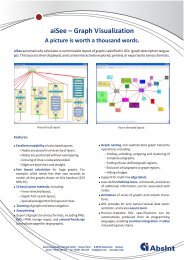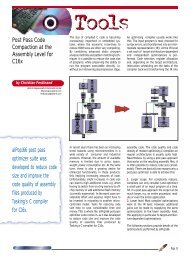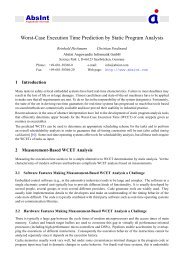5 Graph Description Language (GDL) - Absint
5 Graph Description Language (GDL) - Absint
5 Graph Description Language (GDL) - Absint
Create successful ePaper yourself
Turn your PDF publications into a flip-book with our unique Google optimized e-Paper software.
• invisible<br />
Type: integer<br />
Default value: no default value<br />
Attribute of: top-level graph<br />
<strong>Description</strong>:<br />
This attribute is a synonym for the graph attribute hidden (p. 73).<br />
• late_edge_labels<br />
Type: yes, no<br />
Default value: no<br />
Attribute of: top-level graph, subgraphs<br />
<strong>Description</strong>:<br />
This attribute controls the moment when edge labels are drawn.<br />
– yes<br />
The graph is first partitioned and then edge labels are introduced.<br />
– no<br />
In this case the algorithm first creates labels and then partitions the graph. This option<br />
yields a more compact layout, but may result in more crossings.<br />
• layoutalgorithm<br />
Type: normal, maxdepth, mindepth, ...<br />
Default value: normal<br />
Attribute of: top-level graph, subgraphs<br />
<strong>Description</strong>:<br />
This attribute specifies the basic layout algorithms, there being two main categories. The first<br />
fourteen algorithms describe variations of a hierarchical layout, whereas the last algorithm<br />
implements a force-directed layout. The variations differ in the way nodes are selected for<br />
the various levels in the hierarchical layout.<br />
– normal<br />
This algorithm is the default algorithm. It tries to give all edges the same orientation<br />
and is based on the calculation of strongly connected components. The algorithms<br />
based on depth first search are faster.<br />
– dfs<br />
This algorithm uses a depth first search for layout calculation, but does not enforce<br />
additional constraints pertaining to the degree of nodes. It is faster than the normal<br />
layout algorithm. The result is heavily dependent on the initial order of the nodes in<br />
the specification.<br />
– maxdepth/mindepth<br />
These two algorithms are based on depth first search and are both fast heuristics.<br />
maxdepth tries to increase the depth of the layout. mindepth tries to increase the width<br />
of the layout.<br />
– maxdepthslow/mindepthslow<br />
These slower algorithms might be better if the fast heuristics offered by the algorithms<br />
76





